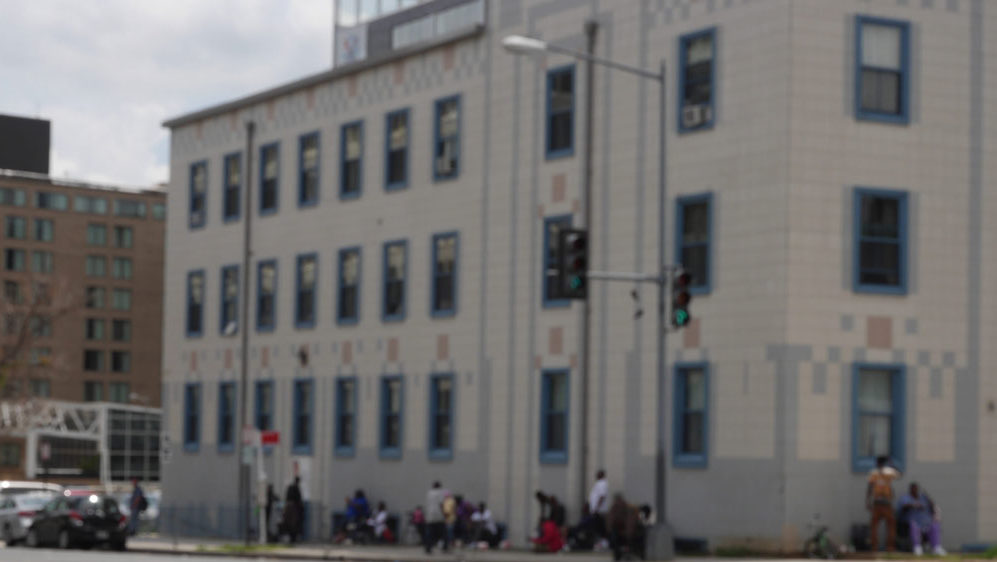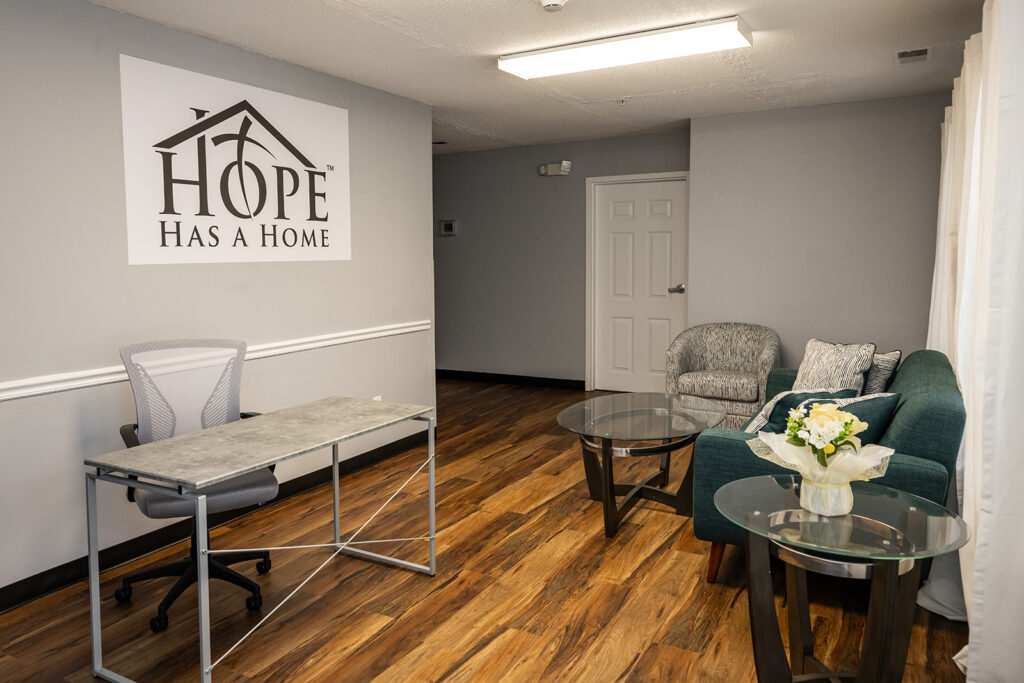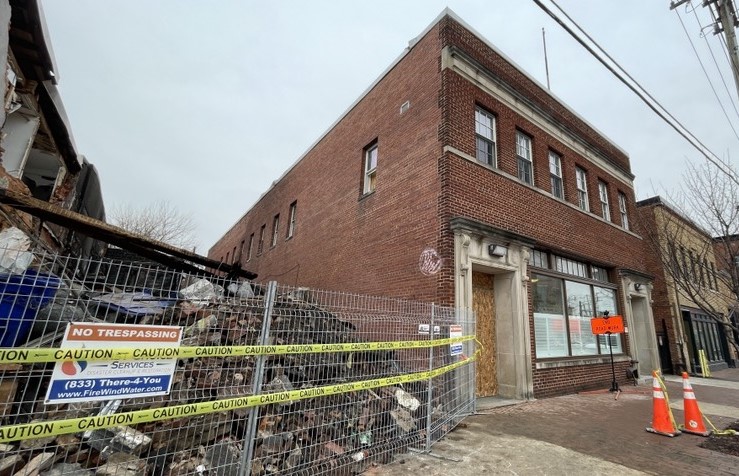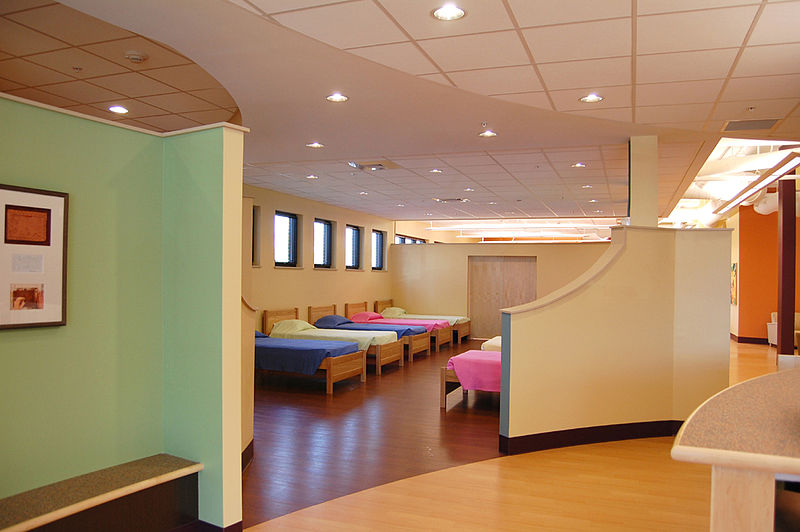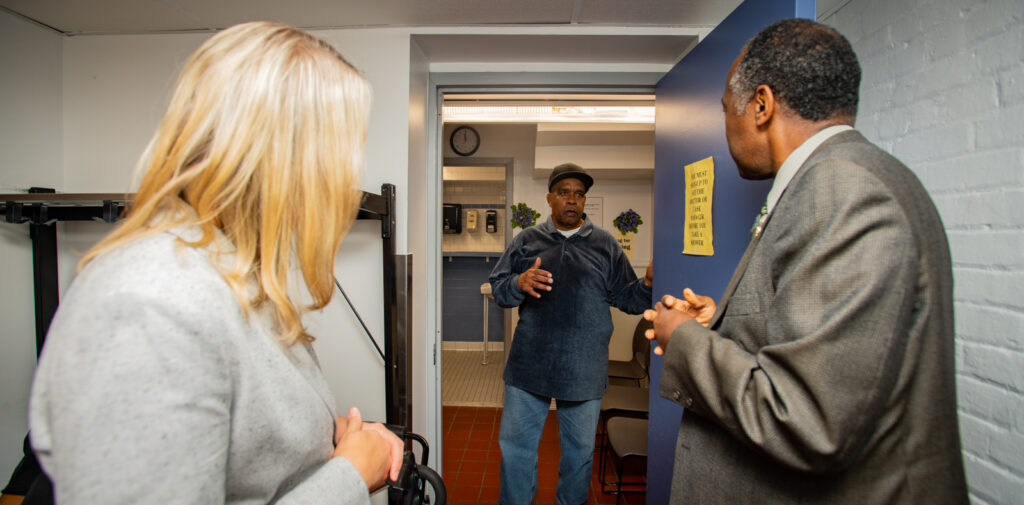On the evening of Wednesday, April 27, more than 20 Community for Creative Nonviolence (CCNV) residents, along with other community members, packed into the CCNV drop-in center at 2nd and D Streets NW — blocks away from the U.S. capitol building.
CCNV shelters more than 1000 single men and women each night and is housed in what used to be the Federal City College building. A cohort of activists, led by Mitch Snyder obtained use of the building through hunger strikes and occupation in 1984. Since then, it has remained one of the largest shelters in the country.
The nonprofit operates alongside DC Central Kitchen, Clean and Sober Streets and several city-funded shelter programs throughout the building. The District owns the building, and the federal requirement that the structure be used for homeless services expires this year. CCNV will be dramatically reduced in size, left with only the Mitch Snyder Arts and Education Center—a small structure which they own—and a parking lot at 2nd and D. Foreseeing this predicament, city government convened a task force of shelter residents, advocates and city officials in 2013 to chart the course of the program’s future. After a year of meetings and disagreements, the task force passed a resolution of guidelines for any future program that would replace CCNV. That was June 2014.
City officials have been nearly silent on the matter since. While the District government has been working with CCNV leadership regarding plans for the future, the residents themselves have been left in the dark until now.
The new administration’s 5-year strategic plan to end homelessness only mentions CCNV once, in a footnote, throughout the 100-page document. As construction along the I-495 corridor moves closer and closer to 2nd and D, and the John L. Young and Open Door shelters have moved out from the Federal City building and into the former Central Union Mission location on 5th Street NW, some CCNV residents have become nervous about the future.
“Given the conditions of the building, I hope we can move toward redevelopment quickly while keeping shelter beds in that downtown location,” said DC Fiscal Policy Institute Policy Analyst Kate Coventry in a phone interview. She attended the Wednesday listening session and was part of the 2013-14 task force.
As of April 30, residents of both the John L. Young and Open Door shelters were expected to have transitioned into the new Patricia Handy Women’s Center on 5th Street, will is managed by N street Village. This event was one of many shakeups prior to the Wednesday meeting. The closure signals the end of New Hope Ministries, which has been running the shelters since the eighties.
“If I’ve got a community and I’ve got beautiful buildings and retailers next door, I know this has got to go,” one meeting attendee said of the encroaching construction.
Deputy Administrator of Homeless Services Dallas Williams assured the crowd that such thinking is unfounded and that, per the task force’s statement of principles approved by D.C. Council, new facilities would be made available before anything happens to CCNV. “We are here to talk about what you would like to see in the future,” he said. Williams also made it clear that CCNV is a private nonprofit and could not be regulated by the Department of Human Services.
Wednesday’s session was called in large part due to a series of requests from resident and long-time community advocate Eric Sheptock. Having spoken with the developer working on the I-495 corridor, Sheptock claimed that the neighboring construction will not be completed until at least 2023, if not later. In the absence of government updates, Sheptock had been distributing flyers featuring his “best guess” as to the future of CCNV after the building is no longer required to be used for homeless services.
Interagency Council on Homelessness (ICH) Director Kristy Greenwalt heard Sheptock and other residents’ concerns at this time and organized the listening session in response to them. Based on the discourse at the meeting, most residents have been waylaid at the shelter for multiple years and frustrated with services provided them, which has bred distrust.
The session was billed as an opportunity to update the 2014 guidelines for CCNV replacement. To this end, three government representatives spent an hour and a half taking advice from residents about which on-site services and physical amenities they value most.
Professional case management, job training and mental health assistance were all top priorities for the gathered men and women.
“It’s as simple as that. There [should be] professional people with actual goals of finding other people stable housing,” said Monsoor Ali, who was applauded by other attendees for this statement. Ali said he has experienced homelessness since he was 15, even though he’s been employed most of his life. He first sought shelter at CCNV in 2002, and described being asked to fill out applications for housing vouchers and other services. Yet, when Ali called the city’s Department of Housing and Community Development to follow-up, his name was on file, but no other personal details had been logged. “It seems like there are people that come to pacify us,” Ali said, “and that there are never any real genuine results for a lot of people here.”
Most in attendance highlighted jobs and job training as the golden ticket to empowering people to pull themselves out of homelessness. One woman in the front row also stressed the importance of fulfilling work in daily life. She described a West Coast recovery program where participants were trained in culinary, sales and management skills. The work brought income to the program and made participants feel good about themselves for contributing. “A hot and a cot…even though I’m so blessed to have shelter… it’s not really working. And that’s why you’re here,” she said.
Functioning laundry facilities along with private shower stalls and bathroom facilities also made the list. “Even prisons have dividers between the shower heads now,” said one attendee.The discussion had to be re-focused multiple times as it drifted to what residents need now, versus what they think is essential for a future facility years down the road. One suggestion was to start bringing more city services to CCNV now, as a bridge between the current program and the future facilities. “We know for job training or whatever, you go to DOES (Department of Employment Services),” explained one resident. “But if you don’t have no type of income because you’re homeless, you don’t even have the resources to get all the way to Minnesota Avenue to go get services.”
Complaints such as this one extended beyond CCNV to the city’s overall safety net, which is undergoing an overhaul as part of the 5-year ICH plan. Another resident criticized most low-barrier shelter hours, which admit residents at 7 p.m. and turn them out the next day by 7 a.m. During the time in-between, they are expected to search for jobs. But the lack of resources and added stressors of figuring out how to get through the day destroy a person’s productivity and effectiveness. “Most people just end up sitting at the library,” explained the resident. “It’s like the system is setting you up to fail.”
The city opened one “day center” last year in Northeast and the ICH claims opening a day center downtown this year is a top priority, especially before MLK Jr. Memorial Library closes for renovations in the fall. For its part, CCNV residents are fortunate enough to come and go as they please throughout the day and retain their bed each night.
An additional suggestion was to utilize the current van service operated by United Planning Organization—which transports residents to-and-from the shelters in addition to responding to shelter hotline calls—to begin transporting shelter residents to doctor appointments, job interviews, and other resources.
Long-term residents reported a general decline in quality at CCNV over the years. “When I first experienced homelessness, I came here, It was pretty dynamic.” said one such resident. He described access to a lot of donated clothing, food and other supplies. “I don’t know when it broke down, but now it’s hard to even get a broom.”
From the program staff managing donations to the city officials taking notes that evening, the need for accountability became a recurring theme. Resident James McGinley received an “amen” from the crowd when he suggested that accountability be added to the service/amenity lists being recorded by the meeting facilitators.
McGinely also made a point of saying that accountability is a two-way street. “Are we doing our part of the work along with accountable social workers, or are we sitting around watching television waiting for others to do our work for us?” he wrote in a follow-up e-mail.
The facilitators had been very attentive and engaging, and Darrel Cason promised to follow-up with residents by typing the lists and returning copies to Eric Sheptock for distribution. However, the attendees wanted more.
“I hope if only one thing comes out of this meeting—it’s what that gentleman said at the beginning,” McGinley said. “There need to be case managers, but not just case managers, case managers with accountability.” He went on to call for transparency in agencies performance too: how many people are being housed, how many people are being moved into jobs and how many [staff members] aren’t doing their jobs. “We’re all spending a lot of time here, including you guys,” McGinley said. “Can we expect any sort of report back from you all: a quarter from now… a year from now… or was this all nice conversation that goes off into nothing?”
The Department of Human Services did not immediately respond to an e-mail request for comment.
Sheptock suggested holding similar community meetings every quarter. At this point in time, the facilitators did not plan to report back to shelter residents. They expected to make sure the ideas listed at the meeting were included in the discussion between CCNV leadership and city officials. There is no concrete plan of action that CCNV and District government are working together on at this time.
The session was a good start to the conversation of what will eventually happen at 425, 2nd Street. A number of residents chose to stay outdoors while their futures were discussed within. Many question the quality and availability of the services currently onsite. “We are drowning in nice people in this city,” McGinley said at the end of the session. “They give us help and help and help and help, and they feel good about themselves – but we don’t get housing and we don’t get jobs. There needs to be accountability.”
